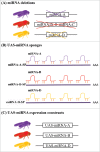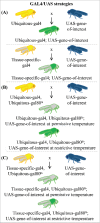The in vivo genetic toolkit for studying expression and functions of Drosophila melanogaster microRNAs
- PMID: 28010188
- PMCID: PMC5324739
- DOI: 10.1080/15476286.2016.1272748
The in vivo genetic toolkit for studying expression and functions of Drosophila melanogaster microRNAs
Abstract
Since the initial reports that a group of small RNAs, now known as microRNAs (miRNAs), regulates gene expression without being translated into proteins, there has been an explosion of studies on these important expression modulators. Drosophila melanogaster has proven to be one of the most amenable animal models for investigations of miRNA biogenesis and gene regulatory activities. Here, we highlight the publicly available genetic tools and strategies for in vivo functional studies of miRNA activity in D. melanogaster. By coupling genetic approaches using available strain libraries with technologies for miRNA expression analysis and target and pathway prediction, researchers' ability to test functional activities of miRNAs in vivo is now greatly enhanced. We also comment on the tools that need to be developed to aid in comprehensive evaluation of Drosophila miRNA activities that impact traits of interest.
Keywords: Drosophila melanogaster; genetics; in vivo; microRNA; tools.
Figures


Similar articles
-
Dme-Hsa Disease Database (DHDD): Conserved Human Disease-Related miRNA and Their Targeting Genes in Drosophila melanogaster.Int J Mol Sci. 2018 Sep 6;19(9):2642. doi: 10.3390/ijms19092642. Int J Mol Sci. 2018. PMID: 30200613 Free PMC article.
-
Prediction and verification of microRNA targets by MovingTargets, a highly adaptable prediction method.BMC Genomics. 2005 Jun 8;6:88. doi: 10.1186/1471-2164-6-88. BMC Genomics. 2005. PMID: 15943864 Free PMC article.
-
Identification of Drosophila MicroRNA targets.PLoS Biol. 2003 Dec;1(3):E60. doi: 10.1371/journal.pbio.0000060. Epub 2003 Oct 13. PLoS Biol. 2003. PMID: 14691535 Free PMC article.
-
Resources and Methods for the Analysis of MicroRNA Function in Drosophila.Methods Mol Biol. 2022;2540:79-92. doi: 10.1007/978-1-0716-2541-5_3. Methods Mol Biol. 2022. PMID: 35980573 Review.
-
miRNA-miRNA crosstalk: from genomics to phenomics.Brief Bioinform. 2017 Nov 1;18(6):1002-1011. doi: 10.1093/bib/bbw073. Brief Bioinform. 2017. PMID: 27551063 Review.
Cited by
-
The role of micro RNAs (miRNAs) in the regulation of Drosophila melanogaster's innate immunity.Fly (Austin). 2022 Dec;16(1):382-396. doi: 10.1080/19336934.2022.2149204. Fly (Austin). 2022. PMID: 36412256 Free PMC article. Review.
-
The Role of miRNAs in Drosophila melanogaster Male Courtship Behavior.Genetics. 2019 Mar;211(3):925-942. doi: 10.1534/genetics.118.301901. Epub 2019 Jan 25. Genetics. 2019. PMID: 30683757 Free PMC article.
References
-
- Chalfie M, Horvitz HR, Sulston JE. Mutations that lead to reiterations in the cell lineages of C. elegans. Cell 1981; 24:59-69; PMID:7237544; http://dx.doi.org/10.1016/0092-8674(81)90501-8 - DOI - PubMed
-
- Lee RC, Feinbaum RL, Ambros V. The C. elegans heterochronic gene lin-4 encodes small RNAs with antisense complementarity to lin-14. Cell 1993; 75:843-54; PMID:8252621; http://dx.doi.org/10.1016/0092-8674(93)90529-Y - DOI - PubMed
-
- Wightman B, Ha I, Ruvkun G. Posttranscriptional regulation of the heterochronic gene lin-14 by lin-4 mediates temporal pattern formation in C. elegans. Cell 1993; 75:855-62; PMID:8252622; http://dx.doi.org/10.1016/0092-8674(93)90530-4 - DOI - PubMed
-
- Pasquinelli AE, Reinhart BJ, Slack F, Martindale MQ, Kuroda MI, Maller B, Hayward DC, Ball EE, Degnan B, Müller P, Spring J, Srinivasan A, Fishman M, Finnerty J, Corbo J, Levine M, Leahy P, Davidson E, Ruvkun G. Conservation of the sequence and temporal expression of let-7 heterochronic regulatory RNA. Nature 2000; 408:86-9; PMID:11081512; http://dx.doi.org/10.1038/35040556 - DOI - PubMed
-
- Reinhart BJ, Slack FJ, Basson M, Pasquinelli AE, Bettinger JC, Rougvie AE, Horvitz HR, Ruvkun G. The 21-nucleotide let-7 RNA regulates developmental timing in Caenorhabditis elegans. Nature 2000; 403:901-6; PMID:10706289; http://dx.doi.org/10.1038/35002607 - DOI - PubMed
Publication types
MeSH terms
Substances
LinkOut - more resources
Full Text Sources
Other Literature Sources
Molecular Biology Databases
